An Analysis of Gender Roles and Discrimination in Newsrooms
VerifiedAdded on 2022/09/12
|9
|2443
|19
Essay
AI Summary
This essay delves into the pervasive issue of gender inequality and discrimination within newsrooms. It examines the historical and ongoing sexism, highlighting the underrepresentation of women in decision-making roles and the persistence of gendered stereotypes. The essay discusses how societal expectations influence professional roles, the male dominance in newsrooms, and the challenges women face in gaining credibility and equal opportunities. It explores the impact of gender bias on female journalists, including limitations in source access and the assignment of stereotypical roles. The analysis extends to the impact of gender on writing styles and the lack of female voices in key areas like sports journalism. The essay provides a critical overview of the structural barriers, lack of role models, and the need for increased diversity and equal opportunities for women in the media industry, drawing on multiple research studies to support its arguments.
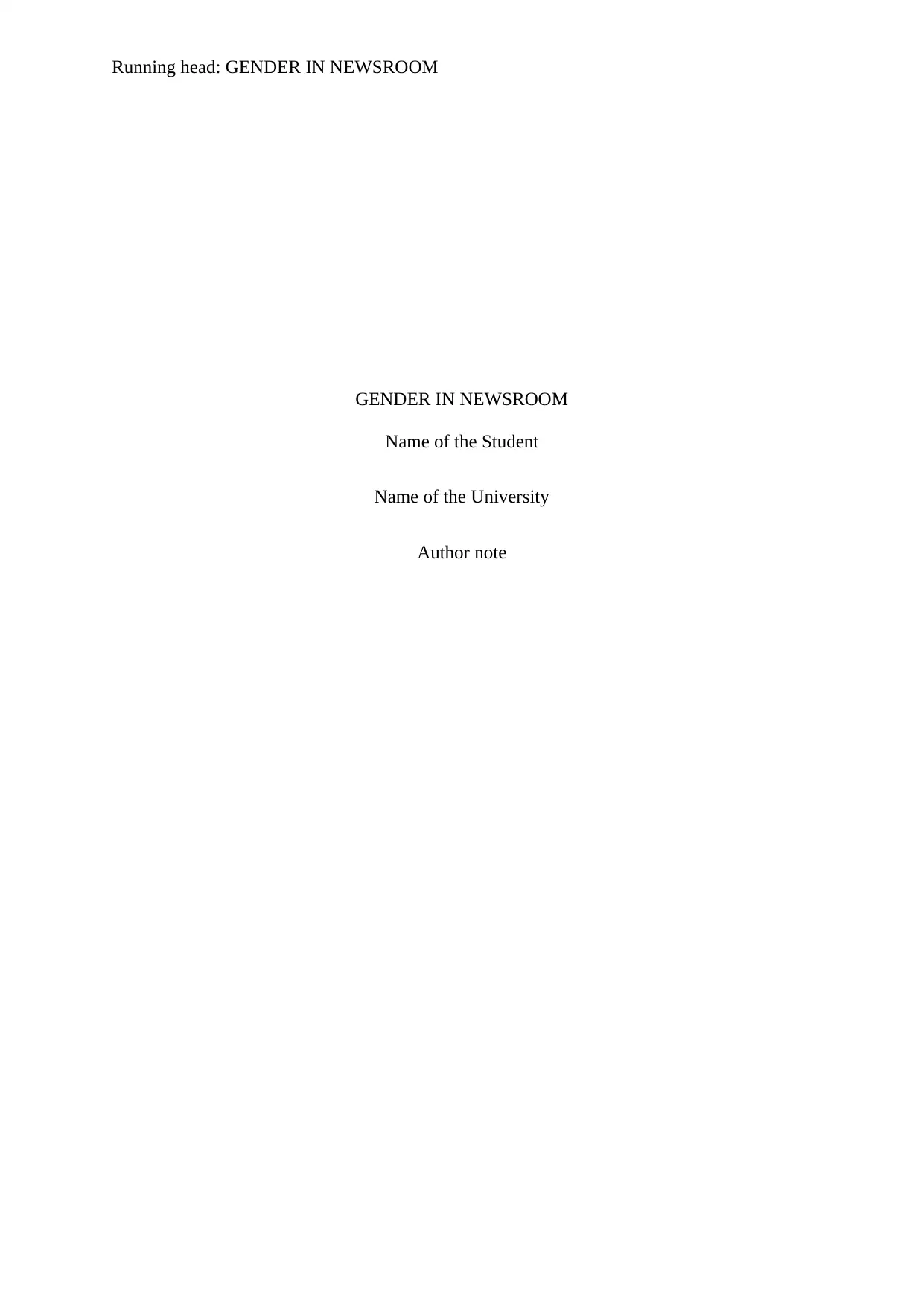
Running head: GENDER IN NEWSROOM
GENDER IN NEWSROOM
Name of the Student
Name of the University
Author note
GENDER IN NEWSROOM
Name of the Student
Name of the University
Author note
Paraphrase This Document
Need a fresh take? Get an instant paraphrase of this document with our AI Paraphraser
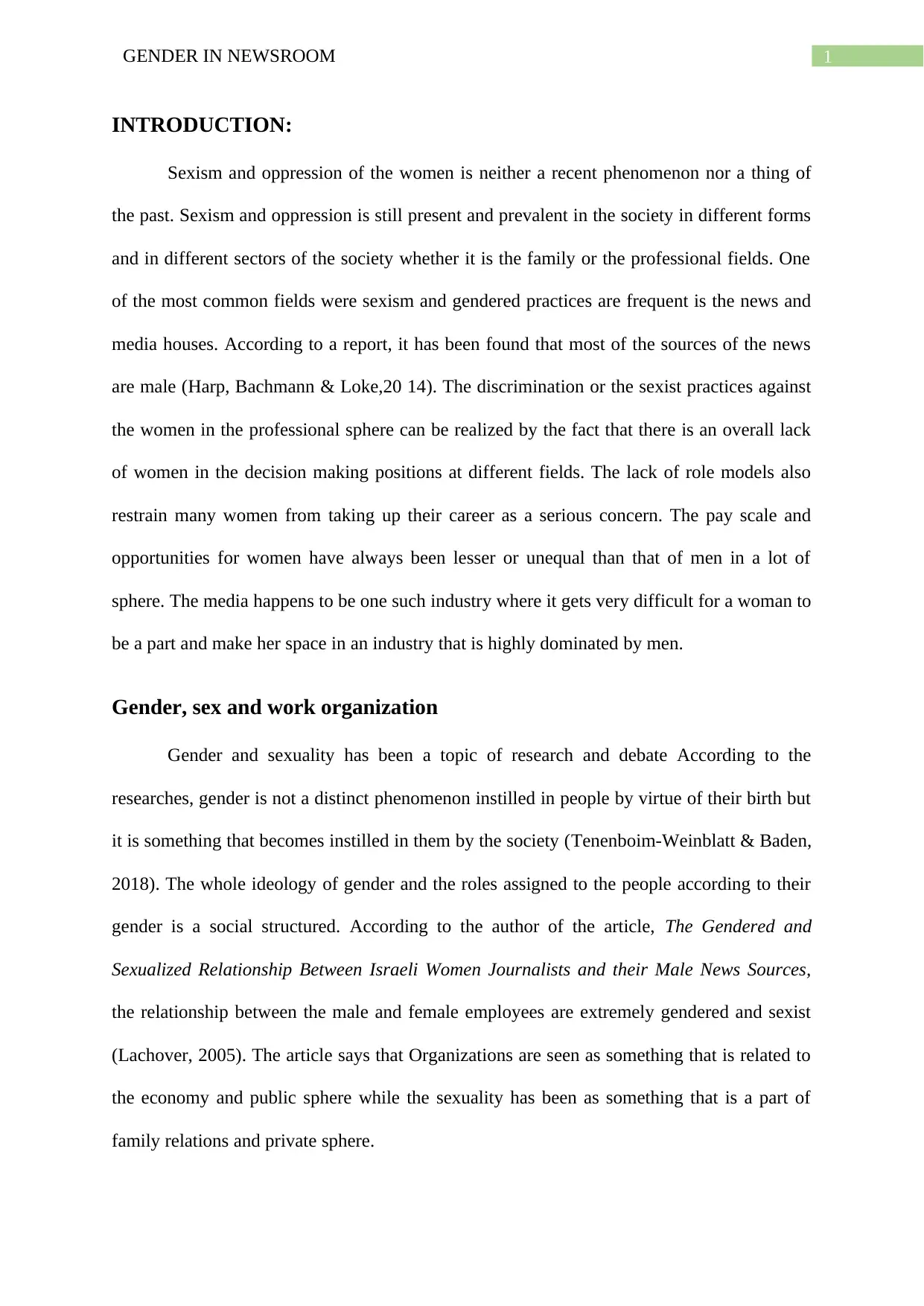
1GENDER IN NEWSROOM
INTRODUCTION:
Sexism and oppression of the women is neither a recent phenomenon nor a thing of
the past. Sexism and oppression is still present and prevalent in the society in different forms
and in different sectors of the society whether it is the family or the professional fields. One
of the most common fields were sexism and gendered practices are frequent is the news and
media houses. According to a report, it has been found that most of the sources of the news
are male (Harp, Bachmann & Loke,20 14). The discrimination or the sexist practices against
the women in the professional sphere can be realized by the fact that there is an overall lack
of women in the decision making positions at different fields. The lack of role models also
restrain many women from taking up their career as a serious concern. The pay scale and
opportunities for women have always been lesser or unequal than that of men in a lot of
sphere. The media happens to be one such industry where it gets very difficult for a woman to
be a part and make her space in an industry that is highly dominated by men.
Gender, sex and work organization
Gender and sexuality has been a topic of research and debate According to the
researches, gender is not a distinct phenomenon instilled in people by virtue of their birth but
it is something that becomes instilled in them by the society (Tenenboim-Weinblatt & Baden,
2018). The whole ideology of gender and the roles assigned to the people according to their
gender is a social structured. According to the author of the article, The Gendered and
Sexualized Relationship Between Israeli Women Journalists and their Male News Sources,
the relationship between the male and female employees are extremely gendered and sexist
(Lachover, 2005). The article says that Organizations are seen as something that is related to
the economy and public sphere while the sexuality has been as something that is a part of
family relations and private sphere.
INTRODUCTION:
Sexism and oppression of the women is neither a recent phenomenon nor a thing of
the past. Sexism and oppression is still present and prevalent in the society in different forms
and in different sectors of the society whether it is the family or the professional fields. One
of the most common fields were sexism and gendered practices are frequent is the news and
media houses. According to a report, it has been found that most of the sources of the news
are male (Harp, Bachmann & Loke,20 14). The discrimination or the sexist practices against
the women in the professional sphere can be realized by the fact that there is an overall lack
of women in the decision making positions at different fields. The lack of role models also
restrain many women from taking up their career as a serious concern. The pay scale and
opportunities for women have always been lesser or unequal than that of men in a lot of
sphere. The media happens to be one such industry where it gets very difficult for a woman to
be a part and make her space in an industry that is highly dominated by men.
Gender, sex and work organization
Gender and sexuality has been a topic of research and debate According to the
researches, gender is not a distinct phenomenon instilled in people by virtue of their birth but
it is something that becomes instilled in them by the society (Tenenboim-Weinblatt & Baden,
2018). The whole ideology of gender and the roles assigned to the people according to their
gender is a social structured. According to the author of the article, The Gendered and
Sexualized Relationship Between Israeli Women Journalists and their Male News Sources,
the relationship between the male and female employees are extremely gendered and sexist
(Lachover, 2005). The article says that Organizations are seen as something that is related to
the economy and public sphere while the sexuality has been as something that is a part of
family relations and private sphere.
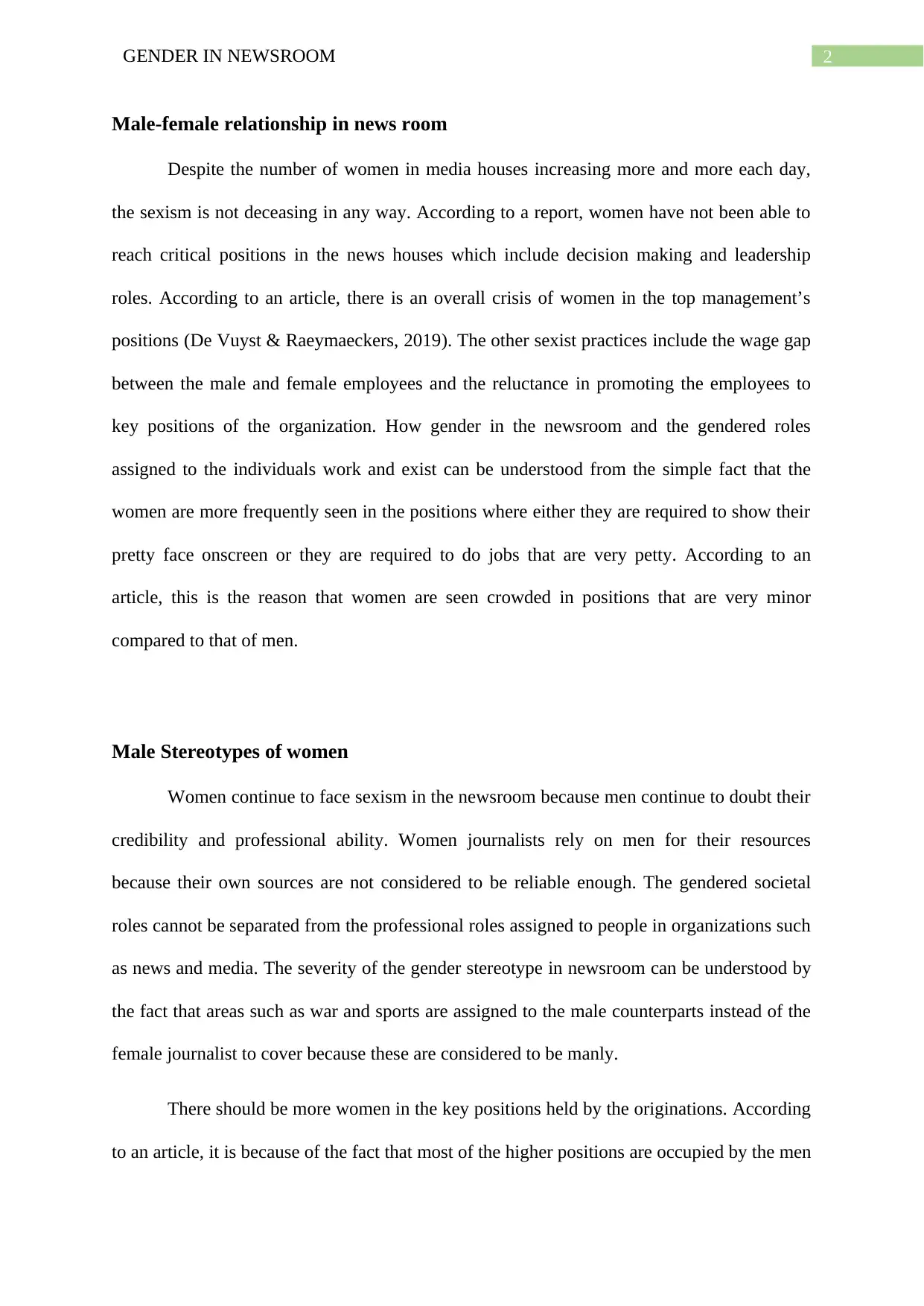
2GENDER IN NEWSROOM
Male-female relationship in news room
Despite the number of women in media houses increasing more and more each day,
the sexism is not deceasing in any way. According to a report, women have not been able to
reach critical positions in the news houses which include decision making and leadership
roles. According to an article, there is an overall crisis of women in the top management’s
positions (De Vuyst & Raeymaeckers, 2019). The other sexist practices include the wage gap
between the male and female employees and the reluctance in promoting the employees to
key positions of the organization. How gender in the newsroom and the gendered roles
assigned to the individuals work and exist can be understood from the simple fact that the
women are more frequently seen in the positions where either they are required to show their
pretty face onscreen or they are required to do jobs that are very petty. According to an
article, this is the reason that women are seen crowded in positions that are very minor
compared to that of men.
Male Stereotypes of women
Women continue to face sexism in the newsroom because men continue to doubt their
credibility and professional ability. Women journalists rely on men for their resources
because their own sources are not considered to be reliable enough. The gendered societal
roles cannot be separated from the professional roles assigned to people in organizations such
as news and media. The severity of the gender stereotype in newsroom can be understood by
the fact that areas such as war and sports are assigned to the male counterparts instead of the
female journalist to cover because these are considered to be manly.
There should be more women in the key positions held by the originations. According
to an article, it is because of the fact that most of the higher positions are occupied by the men
Male-female relationship in news room
Despite the number of women in media houses increasing more and more each day,
the sexism is not deceasing in any way. According to a report, women have not been able to
reach critical positions in the news houses which include decision making and leadership
roles. According to an article, there is an overall crisis of women in the top management’s
positions (De Vuyst & Raeymaeckers, 2019). The other sexist practices include the wage gap
between the male and female employees and the reluctance in promoting the employees to
key positions of the organization. How gender in the newsroom and the gendered roles
assigned to the individuals work and exist can be understood from the simple fact that the
women are more frequently seen in the positions where either they are required to show their
pretty face onscreen or they are required to do jobs that are very petty. According to an
article, this is the reason that women are seen crowded in positions that are very minor
compared to that of men.
Male Stereotypes of women
Women continue to face sexism in the newsroom because men continue to doubt their
credibility and professional ability. Women journalists rely on men for their resources
because their own sources are not considered to be reliable enough. The gendered societal
roles cannot be separated from the professional roles assigned to people in organizations such
as news and media. The severity of the gender stereotype in newsroom can be understood by
the fact that areas such as war and sports are assigned to the male counterparts instead of the
female journalist to cover because these are considered to be manly.
There should be more women in the key positions held by the originations. According
to an article, it is because of the fact that most of the higher positions are occupied by the men
⊘ This is a preview!⊘
Do you want full access?
Subscribe today to unlock all pages.

Trusted by 1+ million students worldwide
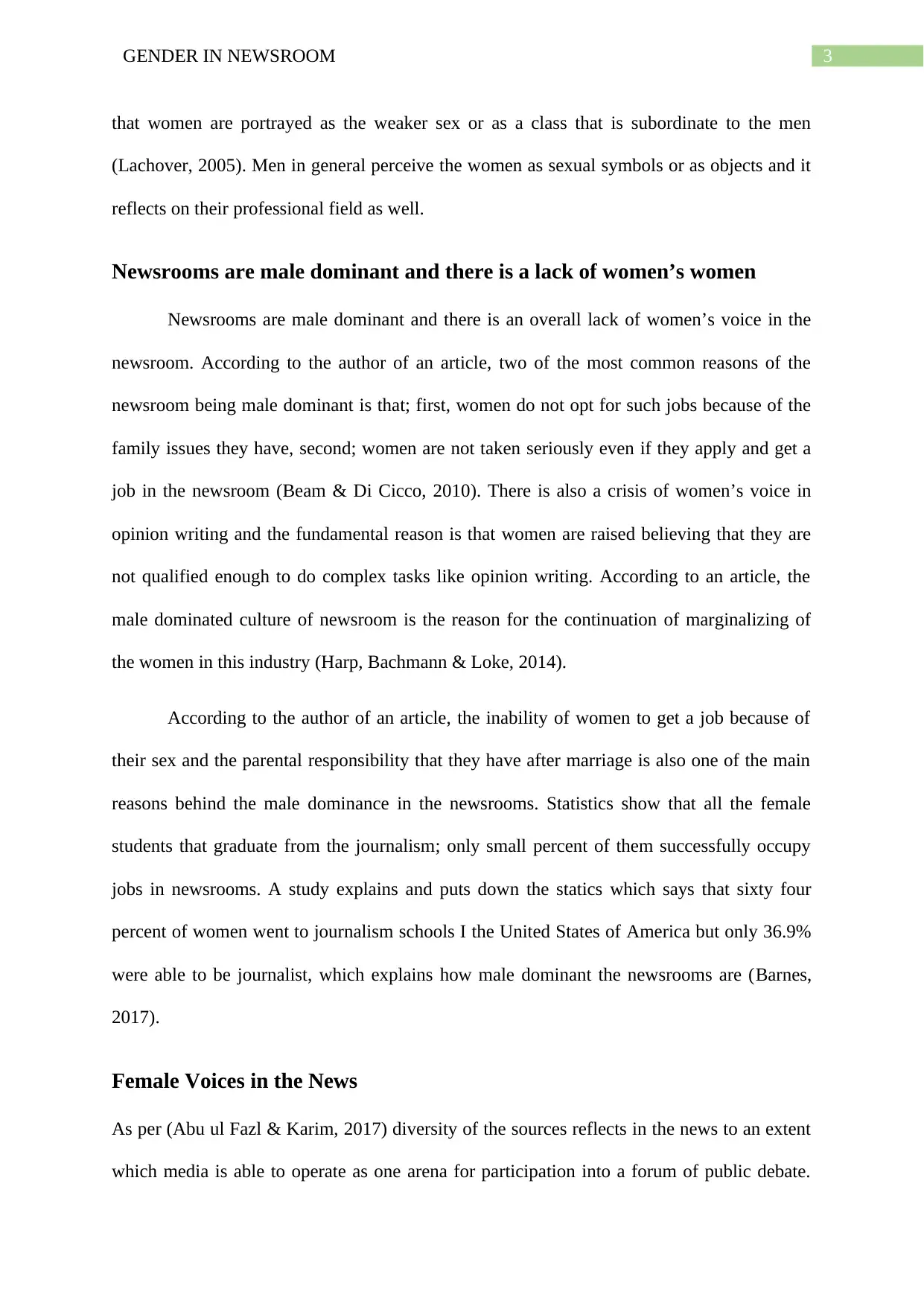
3GENDER IN NEWSROOM
that women are portrayed as the weaker sex or as a class that is subordinate to the men
(Lachover, 2005). Men in general perceive the women as sexual symbols or as objects and it
reflects on their professional field as well.
Newsrooms are male dominant and there is a lack of women’s women
Newsrooms are male dominant and there is an overall lack of women’s voice in the
newsroom. According to the author of an article, two of the most common reasons of the
newsroom being male dominant is that; first, women do not opt for such jobs because of the
family issues they have, second; women are not taken seriously even if they apply and get a
job in the newsroom (Beam & Di Cicco, 2010). There is also a crisis of women’s voice in
opinion writing and the fundamental reason is that women are raised believing that they are
not qualified enough to do complex tasks like opinion writing. According to an article, the
male dominated culture of newsroom is the reason for the continuation of marginalizing of
the women in this industry (Harp, Bachmann & Loke, 2014).
According to the author of an article, the inability of women to get a job because of
their sex and the parental responsibility that they have after marriage is also one of the main
reasons behind the male dominance in the newsrooms. Statistics show that all the female
students that graduate from the journalism; only small percent of them successfully occupy
jobs in newsrooms. A study explains and puts down the statics which says that sixty four
percent of women went to journalism schools I the United States of America but only 36.9%
were able to be journalist, which explains how male dominant the newsrooms are (Barnes,
2017).
Female Voices in the News
As per (Abu ul Fazl & Karim, 2017) diversity of the sources reflects in the news to an extent
which media is able to operate as one arena for participation into a forum of public debate.
that women are portrayed as the weaker sex or as a class that is subordinate to the men
(Lachover, 2005). Men in general perceive the women as sexual symbols or as objects and it
reflects on their professional field as well.
Newsrooms are male dominant and there is a lack of women’s women
Newsrooms are male dominant and there is an overall lack of women’s voice in the
newsroom. According to the author of an article, two of the most common reasons of the
newsroom being male dominant is that; first, women do not opt for such jobs because of the
family issues they have, second; women are not taken seriously even if they apply and get a
job in the newsroom (Beam & Di Cicco, 2010). There is also a crisis of women’s voice in
opinion writing and the fundamental reason is that women are raised believing that they are
not qualified enough to do complex tasks like opinion writing. According to an article, the
male dominated culture of newsroom is the reason for the continuation of marginalizing of
the women in this industry (Harp, Bachmann & Loke, 2014).
According to the author of an article, the inability of women to get a job because of
their sex and the parental responsibility that they have after marriage is also one of the main
reasons behind the male dominance in the newsrooms. Statistics show that all the female
students that graduate from the journalism; only small percent of them successfully occupy
jobs in newsrooms. A study explains and puts down the statics which says that sixty four
percent of women went to journalism schools I the United States of America but only 36.9%
were able to be journalist, which explains how male dominant the newsrooms are (Barnes,
2017).
Female Voices in the News
As per (Abu ul Fazl & Karim, 2017) diversity of the sources reflects in the news to an extent
which media is able to operate as one arena for participation into a forum of public debate.
Paraphrase This Document
Need a fresh take? Get an instant paraphrase of this document with our AI Paraphraser
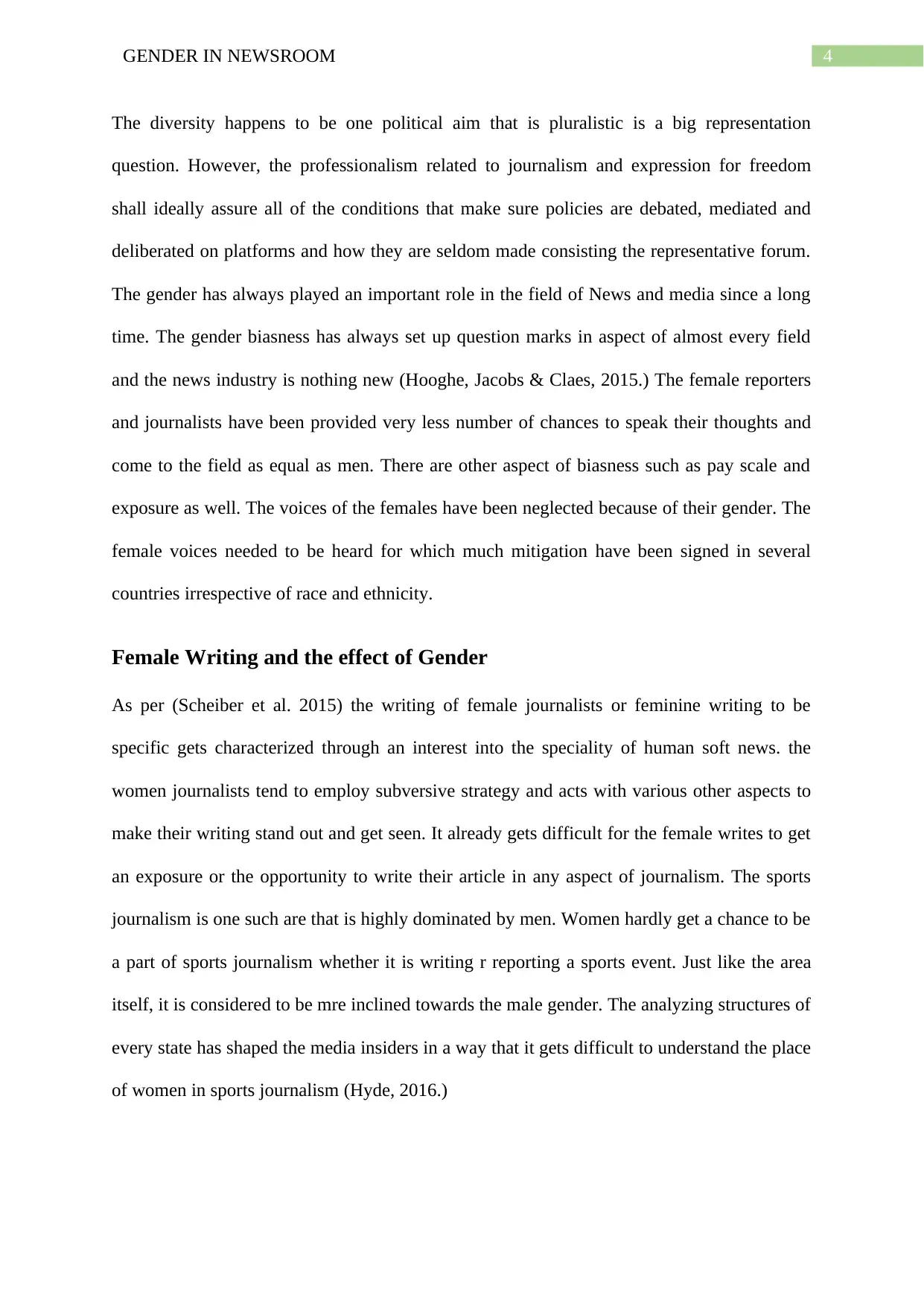
4GENDER IN NEWSROOM
The diversity happens to be one political aim that is pluralistic is a big representation
question. However, the professionalism related to journalism and expression for freedom
shall ideally assure all of the conditions that make sure policies are debated, mediated and
deliberated on platforms and how they are seldom made consisting the representative forum.
The gender has always played an important role in the field of News and media since a long
time. The gender biasness has always set up question marks in aspect of almost every field
and the news industry is nothing new (Hooghe, Jacobs & Claes, 2015.) The female reporters
and journalists have been provided very less number of chances to speak their thoughts and
come to the field as equal as men. There are other aspect of biasness such as pay scale and
exposure as well. The voices of the females have been neglected because of their gender. The
female voices needed to be heard for which much mitigation have been signed in several
countries irrespective of race and ethnicity.
Female Writing and the effect of Gender
As per (Scheiber et al. 2015) the writing of female journalists or feminine writing to be
specific gets characterized through an interest into the speciality of human soft news. the
women journalists tend to employ subversive strategy and acts with various other aspects to
make their writing stand out and get seen. It already gets difficult for the female writes to get
an exposure or the opportunity to write their article in any aspect of journalism. The sports
journalism is one such are that is highly dominated by men. Women hardly get a chance to be
a part of sports journalism whether it is writing r reporting a sports event. Just like the area
itself, it is considered to be mre inclined towards the male gender. The analyzing structures of
every state has shaped the media insiders in a way that it gets difficult to understand the place
of women in sports journalism (Hyde, 2016.)
The diversity happens to be one political aim that is pluralistic is a big representation
question. However, the professionalism related to journalism and expression for freedom
shall ideally assure all of the conditions that make sure policies are debated, mediated and
deliberated on platforms and how they are seldom made consisting the representative forum.
The gender has always played an important role in the field of News and media since a long
time. The gender biasness has always set up question marks in aspect of almost every field
and the news industry is nothing new (Hooghe, Jacobs & Claes, 2015.) The female reporters
and journalists have been provided very less number of chances to speak their thoughts and
come to the field as equal as men. There are other aspect of biasness such as pay scale and
exposure as well. The voices of the females have been neglected because of their gender. The
female voices needed to be heard for which much mitigation have been signed in several
countries irrespective of race and ethnicity.
Female Writing and the effect of Gender
As per (Scheiber et al. 2015) the writing of female journalists or feminine writing to be
specific gets characterized through an interest into the speciality of human soft news. the
women journalists tend to employ subversive strategy and acts with various other aspects to
make their writing stand out and get seen. It already gets difficult for the female writes to get
an exposure or the opportunity to write their article in any aspect of journalism. The sports
journalism is one such are that is highly dominated by men. Women hardly get a chance to be
a part of sports journalism whether it is writing r reporting a sports event. Just like the area
itself, it is considered to be mre inclined towards the male gender. The analyzing structures of
every state has shaped the media insiders in a way that it gets difficult to understand the place
of women in sports journalism (Hyde, 2016.)
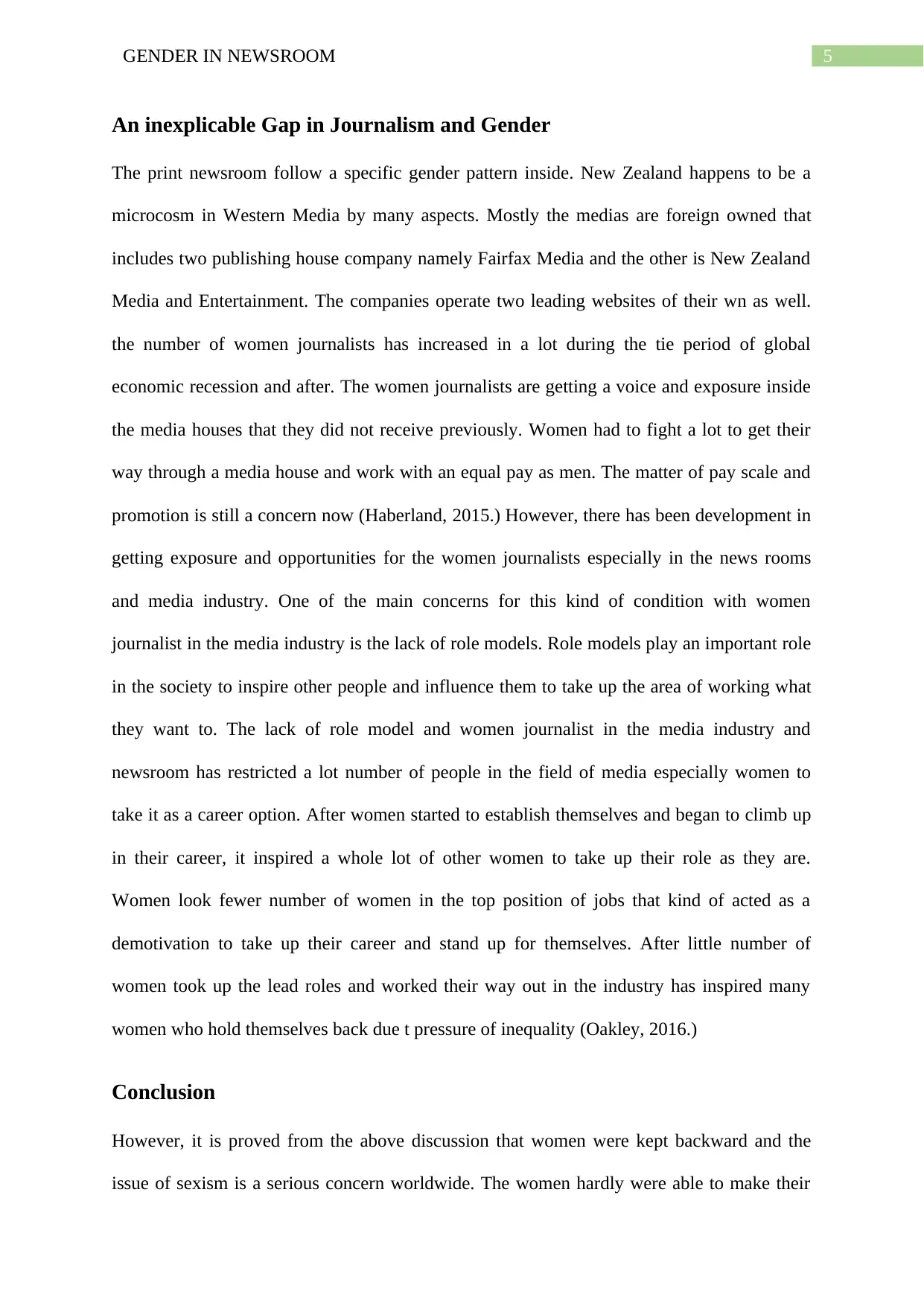
5GENDER IN NEWSROOM
An inexplicable Gap in Journalism and Gender
The print newsroom follow a specific gender pattern inside. New Zealand happens to be a
microcosm in Western Media by many aspects. Mostly the medias are foreign owned that
includes two publishing house company namely Fairfax Media and the other is New Zealand
Media and Entertainment. The companies operate two leading websites of their wn as well.
the number of women journalists has increased in a lot during the tie period of global
economic recession and after. The women journalists are getting a voice and exposure inside
the media houses that they did not receive previously. Women had to fight a lot to get their
way through a media house and work with an equal pay as men. The matter of pay scale and
promotion is still a concern now (Haberland, 2015.) However, there has been development in
getting exposure and opportunities for the women journalists especially in the news rooms
and media industry. One of the main concerns for this kind of condition with women
journalist in the media industry is the lack of role models. Role models play an important role
in the society to inspire other people and influence them to take up the area of working what
they want to. The lack of role model and women journalist in the media industry and
newsroom has restricted a lot number of people in the field of media especially women to
take it as a career option. After women started to establish themselves and began to climb up
in their career, it inspired a whole lot of other women to take up their role as they are.
Women look fewer number of women in the top position of jobs that kind of acted as a
demotivation to take up their career and stand up for themselves. After little number of
women took up the lead roles and worked their way out in the industry has inspired many
women who hold themselves back due t pressure of inequality (Oakley, 2016.)
Conclusion
However, it is proved from the above discussion that women were kept backward and the
issue of sexism is a serious concern worldwide. The women hardly were able to make their
An inexplicable Gap in Journalism and Gender
The print newsroom follow a specific gender pattern inside. New Zealand happens to be a
microcosm in Western Media by many aspects. Mostly the medias are foreign owned that
includes two publishing house company namely Fairfax Media and the other is New Zealand
Media and Entertainment. The companies operate two leading websites of their wn as well.
the number of women journalists has increased in a lot during the tie period of global
economic recession and after. The women journalists are getting a voice and exposure inside
the media houses that they did not receive previously. Women had to fight a lot to get their
way through a media house and work with an equal pay as men. The matter of pay scale and
promotion is still a concern now (Haberland, 2015.) However, there has been development in
getting exposure and opportunities for the women journalists especially in the news rooms
and media industry. One of the main concerns for this kind of condition with women
journalist in the media industry is the lack of role models. Role models play an important role
in the society to inspire other people and influence them to take up the area of working what
they want to. The lack of role model and women journalist in the media industry and
newsroom has restricted a lot number of people in the field of media especially women to
take it as a career option. After women started to establish themselves and began to climb up
in their career, it inspired a whole lot of other women to take up their role as they are.
Women look fewer number of women in the top position of jobs that kind of acted as a
demotivation to take up their career and stand up for themselves. After little number of
women took up the lead roles and worked their way out in the industry has inspired many
women who hold themselves back due t pressure of inequality (Oakley, 2016.)
Conclusion
However, it is proved from the above discussion that women were kept backward and the
issue of sexism is a serious concern worldwide. The women hardly were able to make their
⊘ This is a preview!⊘
Do you want full access?
Subscribe today to unlock all pages.

Trusted by 1+ million students worldwide
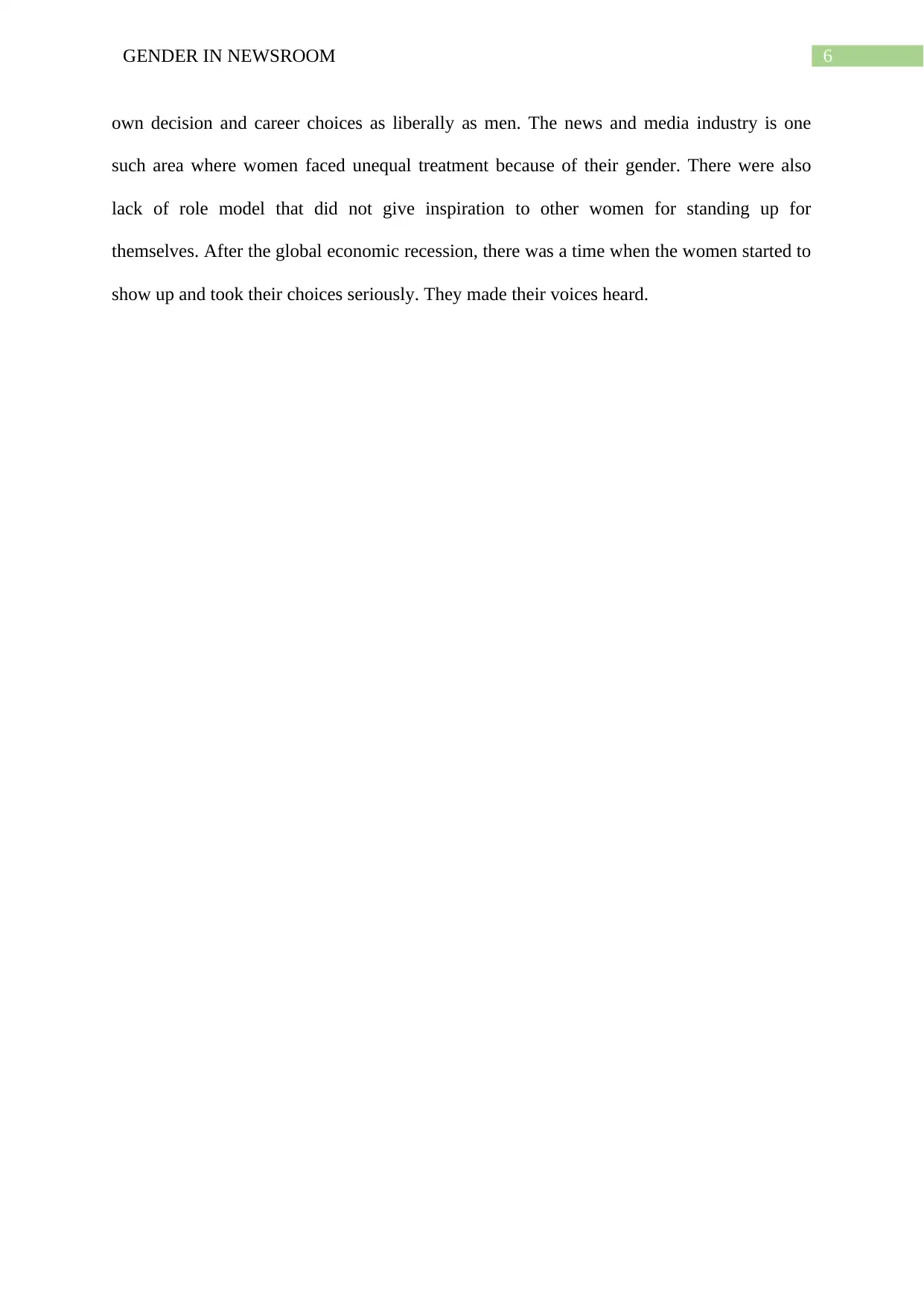
6GENDER IN NEWSROOM
own decision and career choices as liberally as men. The news and media industry is one
such area where women faced unequal treatment because of their gender. There were also
lack of role model that did not give inspiration to other women for standing up for
themselves. After the global economic recession, there was a time when the women started to
show up and took their choices seriously. They made their voices heard.
own decision and career choices as liberally as men. The news and media industry is one
such area where women faced unequal treatment because of their gender. There were also
lack of role model that did not give inspiration to other women for standing up for
themselves. After the global economic recession, there was a time when the women started to
show up and took their choices seriously. They made their voices heard.
Paraphrase This Document
Need a fresh take? Get an instant paraphrase of this document with our AI Paraphraser
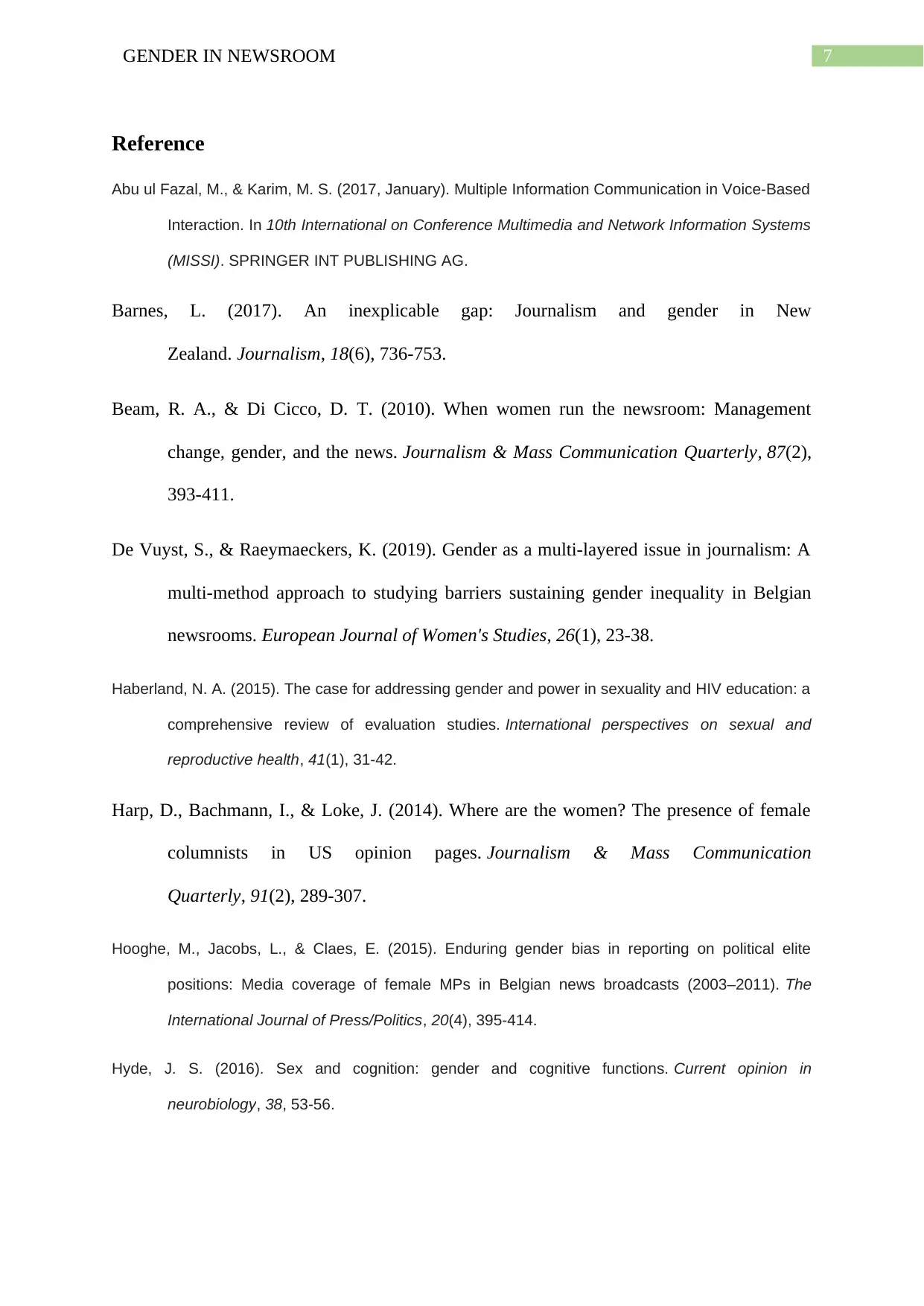
7GENDER IN NEWSROOM
Reference
Abu ul Fazal, M., & Karim, M. S. (2017, January). Multiple Information Communication in Voice-Based
Interaction. In 10th International on Conference Multimedia and Network Information Systems
(MISSI). SPRINGER INT PUBLISHING AG.
Barnes, L. (2017). An inexplicable gap: Journalism and gender in New
Zealand. Journalism, 18(6), 736-753.
Beam, R. A., & Di Cicco, D. T. (2010). When women run the newsroom: Management
change, gender, and the news. Journalism & Mass Communication Quarterly, 87(2),
393-411.
De Vuyst, S., & Raeymaeckers, K. (2019). Gender as a multi-layered issue in journalism: A
multi-method approach to studying barriers sustaining gender inequality in Belgian
newsrooms. European Journal of Women's Studies, 26(1), 23-38.
Haberland, N. A. (2015). The case for addressing gender and power in sexuality and HIV education: a
comprehensive review of evaluation studies. International perspectives on sexual and
reproductive health, 41(1), 31-42.
Harp, D., Bachmann, I., & Loke, J. (2014). Where are the women? The presence of female
columnists in US opinion pages. Journalism & Mass Communication
Quarterly, 91(2), 289-307.
Hooghe, M., Jacobs, L., & Claes, E. (2015). Enduring gender bias in reporting on political elite
positions: Media coverage of female MPs in Belgian news broadcasts (2003–2011). The
International Journal of Press/Politics, 20(4), 395-414.
Hyde, J. S. (2016). Sex and cognition: gender and cognitive functions. Current opinion in
neurobiology, 38, 53-56.
Reference
Abu ul Fazal, M., & Karim, M. S. (2017, January). Multiple Information Communication in Voice-Based
Interaction. In 10th International on Conference Multimedia and Network Information Systems
(MISSI). SPRINGER INT PUBLISHING AG.
Barnes, L. (2017). An inexplicable gap: Journalism and gender in New
Zealand. Journalism, 18(6), 736-753.
Beam, R. A., & Di Cicco, D. T. (2010). When women run the newsroom: Management
change, gender, and the news. Journalism & Mass Communication Quarterly, 87(2),
393-411.
De Vuyst, S., & Raeymaeckers, K. (2019). Gender as a multi-layered issue in journalism: A
multi-method approach to studying barriers sustaining gender inequality in Belgian
newsrooms. European Journal of Women's Studies, 26(1), 23-38.
Haberland, N. A. (2015). The case for addressing gender and power in sexuality and HIV education: a
comprehensive review of evaluation studies. International perspectives on sexual and
reproductive health, 41(1), 31-42.
Harp, D., Bachmann, I., & Loke, J. (2014). Where are the women? The presence of female
columnists in US opinion pages. Journalism & Mass Communication
Quarterly, 91(2), 289-307.
Hooghe, M., Jacobs, L., & Claes, E. (2015). Enduring gender bias in reporting on political elite
positions: Media coverage of female MPs in Belgian news broadcasts (2003–2011). The
International Journal of Press/Politics, 20(4), 395-414.
Hyde, J. S. (2016). Sex and cognition: gender and cognitive functions. Current opinion in
neurobiology, 38, 53-56.
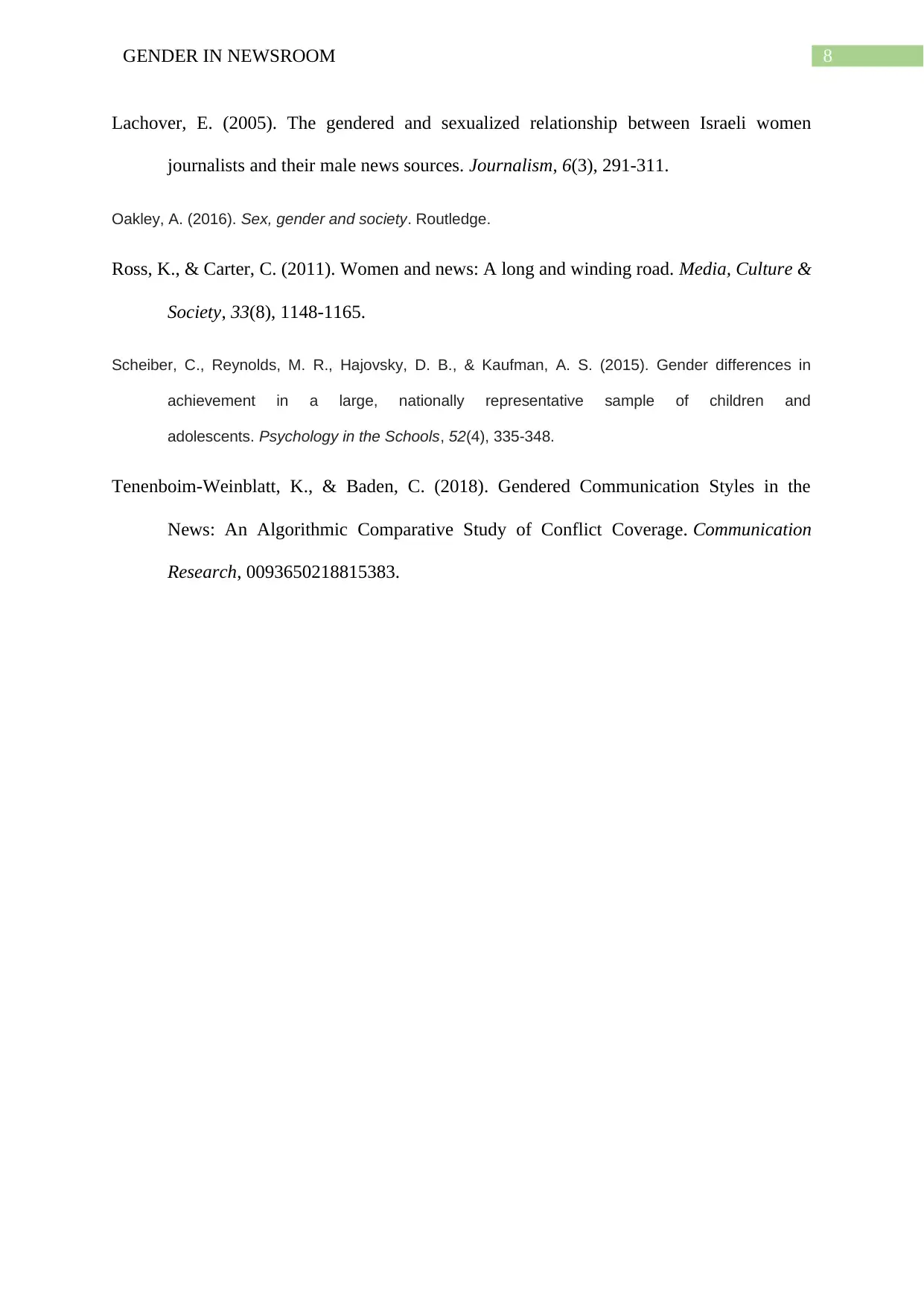
8GENDER IN NEWSROOM
Lachover, E. (2005). The gendered and sexualized relationship between Israeli women
journalists and their male news sources. Journalism, 6(3), 291-311.
Oakley, A. (2016). Sex, gender and society. Routledge.
Ross, K., & Carter, C. (2011). Women and news: A long and winding road. Media, Culture &
Society, 33(8), 1148-1165.
Scheiber, C., Reynolds, M. R., Hajovsky, D. B., & Kaufman, A. S. (2015). Gender differences in
achievement in a large, nationally representative sample of children and
adolescents. Psychology in the Schools, 52(4), 335-348.
Tenenboim-Weinblatt, K., & Baden, C. (2018). Gendered Communication Styles in the
News: An Algorithmic Comparative Study of Conflict Coverage. Communication
Research, 0093650218815383.
Lachover, E. (2005). The gendered and sexualized relationship between Israeli women
journalists and their male news sources. Journalism, 6(3), 291-311.
Oakley, A. (2016). Sex, gender and society. Routledge.
Ross, K., & Carter, C. (2011). Women and news: A long and winding road. Media, Culture &
Society, 33(8), 1148-1165.
Scheiber, C., Reynolds, M. R., Hajovsky, D. B., & Kaufman, A. S. (2015). Gender differences in
achievement in a large, nationally representative sample of children and
adolescents. Psychology in the Schools, 52(4), 335-348.
Tenenboim-Weinblatt, K., & Baden, C. (2018). Gendered Communication Styles in the
News: An Algorithmic Comparative Study of Conflict Coverage. Communication
Research, 0093650218815383.
⊘ This is a preview!⊘
Do you want full access?
Subscribe today to unlock all pages.

Trusted by 1+ million students worldwide
1 out of 9
Related Documents
Your All-in-One AI-Powered Toolkit for Academic Success.
+13062052269
info@desklib.com
Available 24*7 on WhatsApp / Email
![[object Object]](/_next/static/media/star-bottom.7253800d.svg)
Unlock your academic potential
Copyright © 2020–2025 A2Z Services. All Rights Reserved. Developed and managed by ZUCOL.




